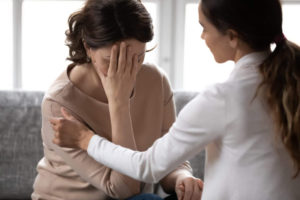Long-term coping strategies can help people who have had a traumatic experience
It is not uncommon for people who have experienced a traumatic event to develop post-traumatic stress disorder (PTSD). In addition, according to the National Center for PTSD, women are more likely than men to develop PTSD as a result of a traumatic event. As a result, people with PTSD often struggle with frequent and intense symptoms of anxiety. These strong symptoms of anxiety often lead people with PTSD to rely on unhealthy ways of coping, including substance abuse (drugs or alcohol), which can make this a life-threatening situation. Fortunately, there are a number of healthy ways people in Boston can cope with anxiety that may help reduce its intensity and frequency and/or make it more tolerable.
1. Support Groups and Social Support
Over and over again, it has been found that finding support from others can be a major factor in helping people overcome the negative effects of a traumatic event and PTSD. Having someone you trust that you can talk to can be very helpful for working through stressful situations or for emotional validation. However, simply having someone available to talk to may not be enough. There are several important pieces to a supportive relationship that may be particularly beneficial in helping someone manage their anxiety.
2. Deep Breathing
Deep breathing can be an important coping skill to learn. It may sound silly but many people do not breathe properly. Natural breathing involves your diaphragm, a large muscle in your abdomen. When you breathe in, your belly should expand. When you breathe out, your belly should fall. Over time, people forget how to breathe this way and instead use their chest and shoulders. This causes short and shallow breaths, which can increase stress and anxiety.
Fortunately, it is not too late to “re-learn” how to breathe deeply with your diaphragm and help protect yourself from stress. Practice this simple exercise to improve your breathing and combat anxiety.
3. Progressive Muscle Relaxation
Using relaxation exercises can be an effective way to reduce your stress and anxiety. One relaxation exercise called progressive muscle relaxation focuses on a person alternating between tensing and relaxing different muscle groups throughout the body. This relaxation method is similar to a pendulum. Complete relaxation of your muscles can be obtained by first going to the other extreme (that is, by tensing your muscles).
In addition, by tensing your muscles (a common symptom of anxiety) and immediately relaxing them, the symptom of muscle tension may become a signal to relax over time.
4. Mindfulness
Using mindfulness for anxiety can be very helpful. Mindfulness has been around for ages. However, mental health professionals are beginning to recognize that mindfulness can have many benefits for people suffering from difficulties such as anxiety and depression. In a nutshell, mindfulness is about being in touch with and aware of the present moment. So often in our lives, we are stuck in our heads, caught up in the anxiety and worries of daily life. This exercise will introduce you to mindfulness and may be helpful getting you “out of your head” and in touch with the present moment.
5. Self-Monitoring
Self-monitoring can be a helpful way of getting a handle on your anxiety symptoms. We are all “creatures of habit.” We often go about our day without thinking, being unaware of much that goes on around us. This may be useful in some situations, but other times, this lack of awareness may make us feel as though our thoughts and emotions are completely unpredictable and unmanageable. We cannot really address uncomfortable symptoms of anxiety without first being aware of what situations bring up these feelings. Self-monitoring is a simple way of increasing this awareness.
6. Self-Soothing
When you are experiencing anxiety, it is important to have ways of coping with those feelings. For example, seeking out social support can be an excellent way of improving your mood. However, the anxiety associated with symptoms of PTSD can sometimes occur unexpectedly, and social support may not be readily available. Therefore, it is important to learn coping strategies that you can do on your own. Coping strategies focused on improving your mood and reducing the anxiety that you can do on your own are sometimes described as self-soothing or self-care coping strategies.
7. Expressive Writing
Using journaling to cope with and express your thoughts and feelings (also called expressive writing) can be a good way of coping with anxiety. Expressive writing has been found to improve physical and psychological health. In regard to PTSD in particular, expressive writing has been found to have a number of benefits including improved coping and posttraumatic growth (or the ability to find meaning in and have positive life changes following a traumatic event), as well as reduced PTSD symptoms, tension, and anger.
8. Distraction
Purposeful use of distraction techniques can actually be of benefit in coping with emotions that are strong and feel uncomfortable, such as anxiety and fear. Distraction is anything you do to temporarily take your attention off of strong emotion. Sometimes, focusing on a strong emotion can make it feel even stronger and more out of control. Therefore, by temporarily distracting yourself, you may give the emotion some time to decrease in intensity, making it easier to manage.
9. Behavioral Activation
Anxiety and avoidance go hand-in-hand. While the avoidance of anxiety-provoking situations may help reduce our anxiety at the moment, in the long-term it may prevent us from living a meaningful and rewarding life (especially as this avoidance grows bigger and bigger). Behavioral activation is a great way of increasing your activity level, as well as how much you engage in positive and rewarding activities. Through behavioral activation, you can reduce your depression and anxiety.








